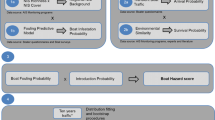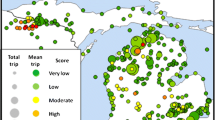Abstract
Models have been well developed describing human movements as vectors of the spread of non-indigenous species (NIS). However, to be maximally useful, predictions need to be integrated with management models of how different policies change human behaviour and lead to concurrent changes in invasion risk. Using the dispersal of freshwater organisms by recreational boaters as our study system and mandatory boat washing as our management strategy, we conducted a survey of recreational boaters (n = 580 respondents, t = 2354 boating trips) in Ontario, Canada, and performed counterfactual analysis of boater behavior across different management options. We developed a model to quantify three responses to mandatory boat washing policies: (1) the continued use of a policy lake; (2) switching to a non-policy lake (“trip redistribution”); or, (3) a reduction in boating trips (“trip loss”). We found that boater and locational traits did not have a significant effect, but even modest user fees at washing stations greatly influenced trip redistribution and loss, explaining 87% of the variation in boater choices. These results indicate that user fees can strongly reduce the effectiveness of boat washing programs to mitigate invasion risk and could have unintended local economic effects, supporting the need to minimize boater expense as a program goal. In contrast, only minor redistribution and loss occurred if users washed but did not pay, and when taken together with the lack of effect for boater and locational traits, suggest that simple human-mediated dispersal models would be sufficient to prioritize management actions under “zero fee” scenarios. Simulating management scenarios using an existing spread model for 10 aquatic NIS in Ontario further emphasized the benefit of zero fees. Although averted invasions increased monotonically with effort (number of lakes with washing stations), the relative effectiveness (number of invasions averted per unit effort) was high even with management of a single lake, given zero fees, but required washing stations at far more lakes to maximize relative effectiveness when user fees were imposed.



Similar content being viewed by others
References
Anderson LG, Dunn AM, Rosewarne PJ, Stebbing PD (2015) Invaders in hot water: a simple decontamination method to prevent the accidental spread of aquatic invasive non-native species. Biol Invasions 17:2287–2297
Bacela-Spychalska K, Grabowski M, Rewicz T, Konopacka A, Wattier R (2013) The ‘killer shrimp’ Dikerogammarus villosus (Crustacea, Amphipoda) invading Apline lakes: overland transport by recreational boats and scuba-diving gear as potential entry vectors? Aquat Conserv 23:606–618
Beyer J, Moy P, Stasio BD (2011) Acute upper thermal limits of three aquatic invasive invertebrates: hot water treatment to prevent upstream transport of invasive species. Environ Manag 47:67–76
Bossenbroek JM, Kraft CE, Nekola JC (2001) Prediction of long-distance dispersal using gravity models: zebra mussel invasion of inland lakes. Ecol Appl 11:1778–1788
Bossenbroek JM, Johnson LE, Peters V, Lodge DM (2007) Forecasting the expansion of Zebra Mussels in the United States. Conserv Biol 21:800–810
Burnham KP, Anderson DR (2002) Model selection and multimodel inference: a practical information-theoretic approach. Springer, New York
Calder C, Lavine M, Muller P, Clark J (2003) Incorporating multiple sources of stochasticity into dynamic population models. Ecology 84:1395–1402
Challen DW, Hagger AJ (1983) Counter-factual analysis. In: Challen DW, Hagger AJ (eds) Macroeconomic systems: construction, validation and applications. Springer, New York, pp 194–204
Chivers C, Leung B (2012) Predicting invasions: alternative models of human-mediated dispersal and interactions between dispersal network structure and Allee effects. J Appl Ecol 49:1113–1123
Chivers C (2014) Predictive invasion ecology and decisions under uncertainty (Doctoral dissertation). McGill University, Montreal
Dillman DA (2000) Mail and Internet surveys: the tailored design method, 2nd edn. Wiley, Hoboken
Drake DAR, Mandrak NE (2014) Bycatch, bait, anglers, and roads: quantifying vector activity and propagule introduction risk across lake ecosystems. Ecol Appl 24:877–894
Drake DAR (2017) Overland spread of aquatic invasive species among freshwater ecosystems due to recreational boating in Canada. DFO Can Sci Advis Sec Res Doc. (in press)
Edwards PK, Leung B (2009) Re-evaluating eradication of nuisance species: invasion of the tunicate, Ciona intestinalis. Front Ecol Environ 7:326–332
Epanchin-Niell RS, Hastings A (2010) Controlling established invaders: integrating economics and spread dynamics to determine optimal management. Ecol Lett 13:528–541
Gertzen EL, Leung B (2011) Predicting the spread of invasive species in an uncertain world: accommodating multiple vectors and gaps in temporal and spatial data for Bythotrephes longimanus. Biol Invasions 13:2433–2444
Gertzen EL, Familiar O, Leung B (2008) Quantifying invasion pathways: fish introductions from the aquarium trade. Can J Fish Aquat Sci 65:1265–1273
Haider W (2002) Stated preference & choice models—a versatile alternative to traditional recreation research. In: Arnberger A, Brandenburg C, Muhar A (eds) Monitoring and management of visitor flows in recreational and protected areas conference proceedings. Bodenkultur University, Vienna, pp 115–121
Heckman JJ, Vytlacil EJ (2007) Econometric evaluation of social programs, part I: causal models, structural models and econometric policy evaluation. In: Heckman JJ, Leamer EE (eds) Handbook of econometrics, volume 6, part b. Elsevier, Amsterdam, pp 4779–4874
Jensen DA (2010) Assessing the effectiveness of aquatic invasive species outreach influencing boater behaviour in five states. Masters Thesis, University of Minnesota Duluth
Johnson LE, Carlton JT (1996) Post-establishment spread in large-scale invasions: dispersal mechanisms of the zebra mussel Dreissena polymorpha. Ecology 77:1686–1690
Johnson LE, Ricciardi A, Carlton JT (2001) Overland dispersal of aquatic invasive species: a risk assessment of transient recreational boating. Ecol Appl 11:1789–1799
Koch FH, Yemshanov D, Magarey RD, Smith WD (2012) Dispersal of invasive forest insects via recreational firewood: a quantitative analysis. J Econ Entomol 105:438–450
Leung B, Drake JM, Lodge DM (2004) Predicting invasions: propagule pressure and the gravity of Allee effects. Ecology 85:1651–1660
Leung B, Bossenbroek JM, Lodge DM (2006) Boats, pathways, and aquatic biological invasions: estimating dispersal potential with gravity models. Biol Invasions 8:241–254
MacIsaac HJ, Borbely JVM, Muirhead JR, Graniero PA (2004) Backcasting and forecasting biological invasions of inland lakes. Ecol Appl 14:773–783
MacPherson AJ, Moore R, Provencher B (2006) A dynamic principal-agent model of human-mediated aquatic species invasions. Agric Resour Econ Rev 35:144–154
Mandrak NE, Cudmore B (2015) Risk assessment: cornerstone of an aquatic invasive species strategy. Aquat Ecosyst Health 18:312–320
Morandi MJ, Manning NF, Bossenbroek JM, Jerde CL (2015) Assessing the influence of different inland lake management strategies on human-mediated invasive species spread. Manag Biol Invasions 6:57–69
Muirhead JR, MacIsaac HJ (2011) Evaluation of stochastic gravity model selection for use in estimating non-indigenous species dispersal and establishment. Biol Invasions 13:2445–2458
Padilla DK, Williams SL (2004) Beyond ballast water: aquarium and ornamental trades as sources of invasive species in aquatic ecosystems. Front Ecol Environ 2:131–138
Papenfuss JT, Phelps N, Fulton D, Venturelli PA (2015) Smartphones reveal angler behaviour: a case study of a popular mobile fishing application in Alberta, Canada. Fisheries 40:318–327
Parry H, Sadler R, Kriticos D (2013) Practical guidelines for modelling post-entry spread in invasion ecology. NeoBiota 18:41–66
Perrings C, Williamson M, Barbier EB, Delfino D, Dalmazzone S, Shogren J, Simmons P, Watkinson A (2002) Biological invasion risks and the public good: an economic perspective. Conserv Ecol 6:1–7
Peters JA, Lodge DM (2009) Invasive species policy at the regional level: a multiple weak links problem. Fisheries 34:373–381
Phaneuf DJ (2013) Heterogeneity in environmental demand. Annu Rev Resour Econ 5:227–244
Prasad AM, Iverson LR, Peters MP, Bossenbroek JM, Matthews SN, Davis Sydnor T, Schwartz MW (2010) Modeling the invasive emerald ash borer risk of spread using a spatially explicit cellular model. Landsc Ecol 25:353–369
Rothlisberger JD, Chadderton WL, McNulty J, Lodge DM (2010) Aquatic invasive species transport via trailered boats: what is being moved, who is moving it, and what can be done. Fisheries 35:121–132
Simberloff D, Parker IM, Windle PN (2005) Introduced species policy, management, and future research needs. Front Ecol Environ 3:12–20
Stohlgren TJ, Schnase JL (2006) Risk analysis for biological hazards: what we need to know about invasive species. Risk Anal 26:163–173
Timar L, Phaneuf DJ (2009) Modeling the human-induced spread of an aquatic invasive: the case of the zebra mussel. Ecol Econ 68:3060–3071
Vander Zanden MJ, Olden JD (2008) A management framework for preventing the secondary spread of aquatic invasive species. Can J Fish Aquat Sci 65:1512–1522
Acknowledgements
This work was supported by funding through the Canadian Aquatic Invasive Species Network, a Natural Sciences and Engineering Research Council Discovery Grant to BL, and a University of Toronto Scarborough Post-doctoral Fellowship to DARD. We thank the members of Canada’s National Aquatic Invasive Species Committee for supplying information about boat inspection and washing programs. CC and BL conducted social surveys, designed the experiment, and developed the analytical approach. CC, DARD, and BL wrote the manuscript.
Author information
Authors and Affiliations
Corresponding author
Appendix
Appendix
Counterfactual survey administered to boaters in Ontario, Canada during January and February 2011: responses describe boating activity undertaken during 2010 season


Part 2: In order to reduce the spread of harmful invasive species, consider the following policy
Upon removing your boat from the lake, you would be required to pass your boat and trailer through a hull, trailer and gear cleaning station.
At this station, you would be required to:
-
Empty all bilges and live wells
-
Ensure that all ropes, fishing lines, propellers, and trailer parts are clear of any plants or animals
Time required to complete the cleaning process will vary depending on the size of your vessel, but it is estimated to take approximately 15 min.
The cost of this mandatory procedure is 2$.

Rights and permissions
About this article
Cite this article
Chivers, C., Drake, D.A.R. & Leung, B. Economic effects and the efficacy of intervention: exploring unintended effects of management and policy on the spread of non-indigenous species. Biol Invasions 19, 1795–1810 (2017). https://doi.org/10.1007/s10530-017-1391-7
Received:
Accepted:
Published:
Issue Date:
DOI: https://doi.org/10.1007/s10530-017-1391-7




